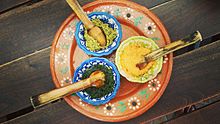Salsa (sauce)

|
|
| Type | Sauce |
|---|---|
| Region or state | Mexico |
| Main ingredients | Varies |
| |
|
Salsa is the Italian and Spanish term for sauce, and in English-speaking countries usually refers to the sauces typical of Mexican cuisine known as salsas picantes, particularly those used as dips.
Salsa is often a tomato-based sauce or dip that is a heterogeneous mixture that includes additional ingredients such as onions, chilies, beans, corn, and various spices. It is typically piquant, ranging from mild to extremely hot.
The word salsa entered the English language from the Spanish salsa ("sauce"), which itself derives from the Latin salsa ("salty"), from sal ("salt"). The native Spanish pronunciation is [ˈsalsa]. In American English it is pronounced /ˈsɑːlsə/, while in British English it is pronounced as /ˈsælsə/.
Mexican salsas were traditionally produced using the mortar and pestle-like molcajete, although blenders are now more commonly used. The Maya made salsa also, using a mortar and pestle. Well-known salsas include:
There are many other salsas, both traditional and nouveau, some are made with mint, pineapple, or mango.
Outside of Mexico and Central America, the following salsas are common to each of the following regions; in Argentina and the Southern Cone, chimichurri sauce is common. Chimichurri is "a spicy vinegar-parsley sauce that is the salsa (and leading condiment) in Argentina and Uruguay, served with grilled meat. It is made of chopped fresh parsley and onion, seasoned with garlic, oregano, salt, cayenne chilies and black pepper and bound with oil and vinegar." In Costa Rica, dishes are prepared with salsa Lizano, a thin, smooth, light brown sauce. In Cuba and the Caribbean, a typical salsa is mojo. Unlike the tomato-based salsas, mojo typically consists of olive oil, garlic, and citrus juice, and is used both to marinate meats and as a dipping sauce. In Peru, a traditional salsa is peri peri or piri piri sauce: "The national condiment of Peru, peri-peri sauce is made in medium to hot levels of spiciness—the more chili, or the hotter variety of chile used, the hotter the sauce. Original peri-peri uses the African bird’s eye chili (the African word for the chili is peri-peri). Milder sauces may use only cayenne and serrano chilies. To a base of vinegar and oil, garlic and lemon juice are added, plus other seasonings, which often include paprika or tomato paste for flavor and color, onions and herb—each company has its own recipe. It is also used as a cooking sauce."
...
Wikipedia
